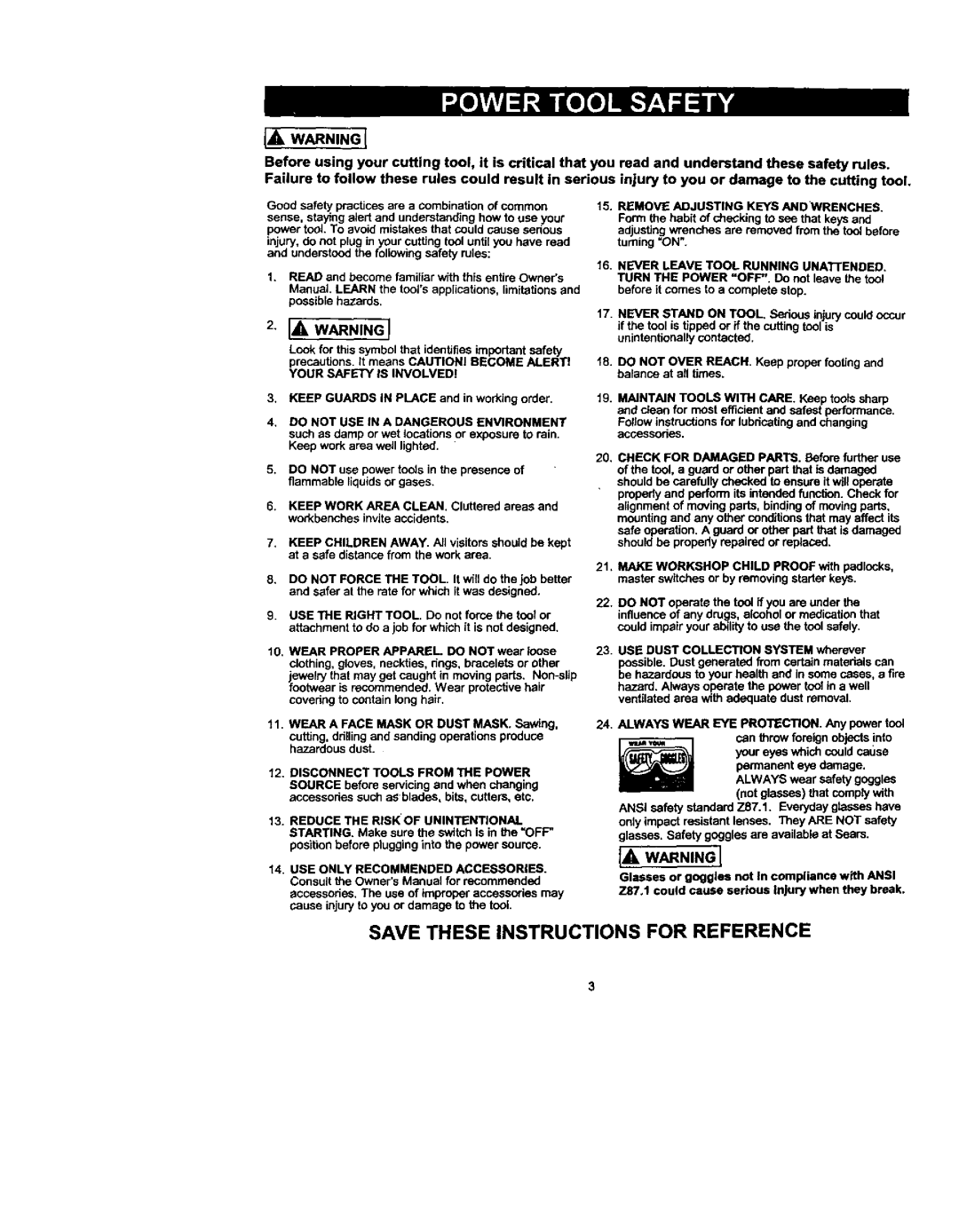
IA WARNING]
Before using your cutting tool, it is critical that you Failure to follow these rules could result in serious
read and understand these safety rules. injury to you or damage to the cutting tool,
Good safety practices are a combination of common
sense, staying alert and understanding how to use your power tool. To avoid mistakes that could cause serious
injury, do not plug in your cutting tool until you have read and understood the following safety rules:
1.READ and become familiar with this entire Owner's
Manual. LEARN the tool'sapplications, limitations and possible hazards.
2.I& WARNINGI
Look for this symbol that identifies important safety precautions, it means CAUTIONI BECOME ALERTI YOUR SAFETY IS INVOLVED!
3.KEEP GUARDS IN PLACE and in working order.
4.DO NOT USE IN A DANGEROUS ENVIRONMENT
such as damp or wet locations or exposure to rain. Keep work area well lighted.
5, DO NOT use power tools in the presence of flammable liquidsor gases.
6.KEEP WORK AREA CLEAN. Cluttered areas and workbenches invite accidents.
7.KEEP CHILDREN AWAY. Ati visitors should be kept at a safe distance from the work area.
15.REMOVE ADJUSTING KEYS ANDWRENCHES.
Form the habit of checking tOsee that keys and adjusting wrenches are removed from the tool before taming =ON".
16.NEVER LEAVE TOOL RUNNING
before it comes to a complete stop.
17.NEVER STAND ON TOOL. Serious injury could occur
if the tool is tipped or if the cutting tool is unintentionally contacted.
'f8.DO NOT OVER REACH. Keep proper footing and balance at aft times.
t9. MAINTAIN TOOLS WITH CARE. Keep toots sharp and olean for most efficient and safest performance.
Follow instructions for lubricating and changing accessories.
20, CHECK FOR DAMAGED PARTS. Before further use
of the tool, a guard or other part that is damaged should be carefully checked to ensure it will operate
properly and perform its intended function. Check for
alignment of moving parts, binding of moving parts, mounting and any other conditions that may effect its
safe operation. A guard or other part that is damaged should be properly repaired or replaced.
8.DO NOT FORCE THE TOOL It will do the job better and safer at the rate for which itwas designed,
9.USE THE RIGHT TOOL Do not foree the tool or attachment to do a job for which it is not designed.
10.WEAR PROPER APPAREL DO NOT wear loose clothing, gloves, neckties, rings, bracelets or other
ewelry that may get caught in moving parts.
11.WEAR A FACE MASK OR DUST MASK. Sawing,
cutting, drillingand sanding operations produce hazardous dust.
12.DISCONNECT TOOLS FROM THE POWER
SOURCE before sewicing and when changing accessories such as blades, bits, cutters, etc,
13.REDUCE THE RISKOF UNINTENTIONAL STARTING. Make sure the switch is in the "OFF" position before plugging into the power source.
21, MAKE WORKSHOP CHILD PROOF with padlocks, master switches or by removing starter keys.
22.DO NOT operate the tool if you are under the influence of any drugs, alcohol or medication that could impair your ability to use the tool safely.
23.USE DUST COLLECTION SYSTEM wherever possible. Dust generated fTom certain materials can be hazardous to your health and in some cases, a fire
hazard. Always operate the power tool in a well ventJlatad area with adequate dust removal.
24.ALWAYS WEAR EYE PROTECTION. Any power tool
your eyes which could catJse
permanent eye damage.
can throw foreign objects into ALWAYS wear safety goggles
(not glasses) that comply with
ANSI safety standard 7_87.1. Everyday gtasaes have only impact resistant lenses. 111eyARE NOT safety glasses. Safety goggles are available at Sears.
14.USE ONLY RECOMMENDED ACCESSORIES. Consult the Owner'sManual for recommended accessodss. The use of improper accessories may cause injury to you or damage to the tool
1A WARNING I
GlaSses or goggles not In compliance with ANSI Z87,1 could cause serious Injury when they break.
SAVE THESEINSTRUCTIONS FOR REFERENCE
3
